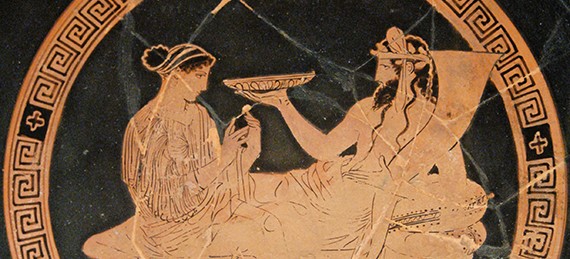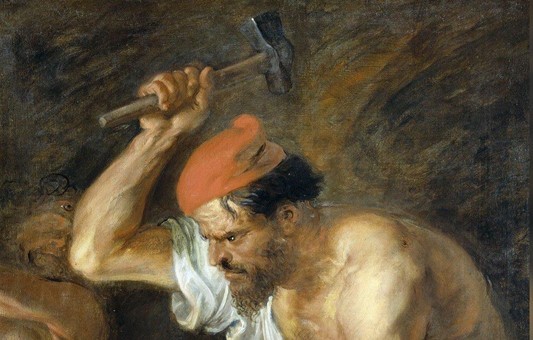Women in the Odyssey: Goddesses, wives, lovers, and threats


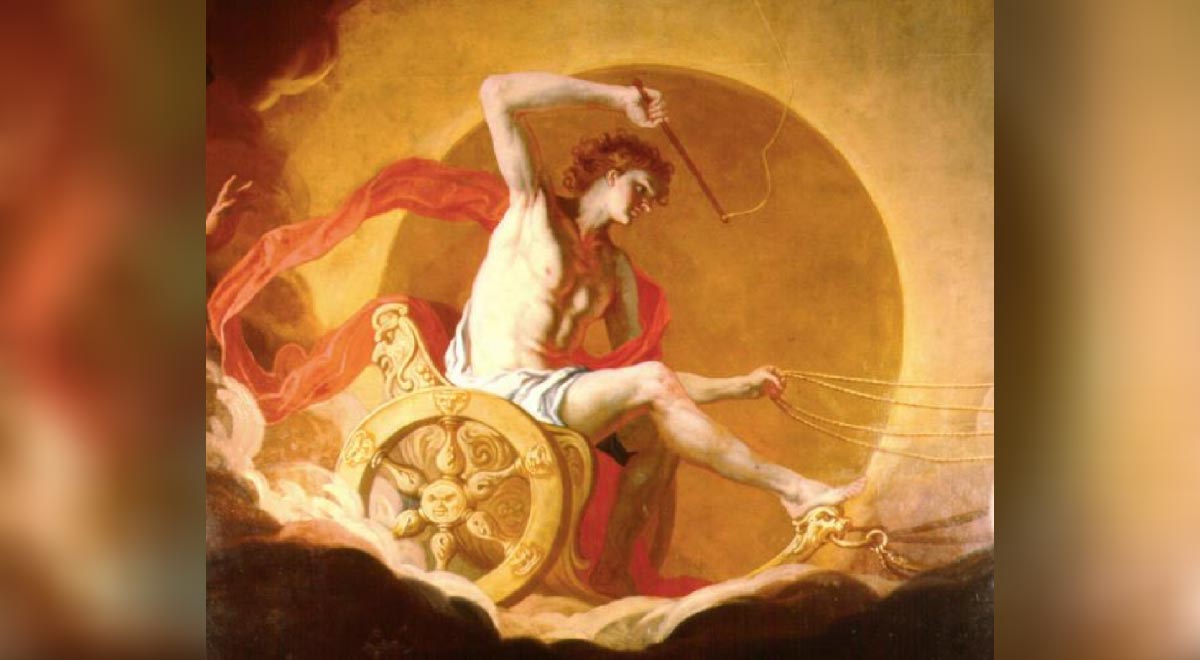
By Alicia McDermott, Contributing writer, Ancient Origins
An unpunished second-generation Titan of Greek myth, Helios was a deity who was important, but not always recognized for his powers. Until his role was usurped by a newer god, Helios was the deity of the life-giving, season-changing sun. He appeared in artwork riding his horse-drawn chariot across the sky and was a firsthand witness to several major events in the lives of other gods and goddesses, but Helios generally seemed to pass along in the background, seeing everything going on both on earth and in the heavens as he made sure to follow his daily routine.
Titans, Nymphs, Kings, and Oceanids: Helios’ Extensive Family
Helios’ parents were the Titans Hyperion, god of light, and Theia, goddess of sight. His sisters were Selene (the Moon) and Eos (Dawn). He was born/created in what is called the Golden Age of Greek Mythology and was responsible for bringing light to the world as the god of the sun. That role would gradually be usurped.
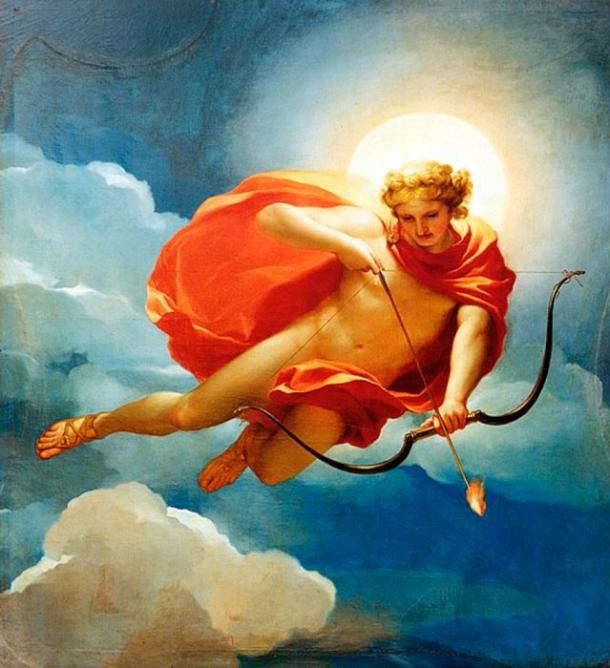
‘Helios as Personification of Midday’ (1765) by Anton Raphael Mengs.
His lovers include the Oceanids Perseis (whom some sources call his wife) and Clymene as well as the nymphs Crete and Rhodes.
His daughters with Persis include the famed sorceresses Circe, a lover to Odysseus, and Pasiphae, King Minos of Crete’s wife. His two sons with Perseis were King Aietes (Aeete) of Kolchis (Colchis) and King Perses of Persia.
Phaethon was his son born from Helios’ relation with Clymene and he had three (or five) daughters with her, known collectively as the Heliades.
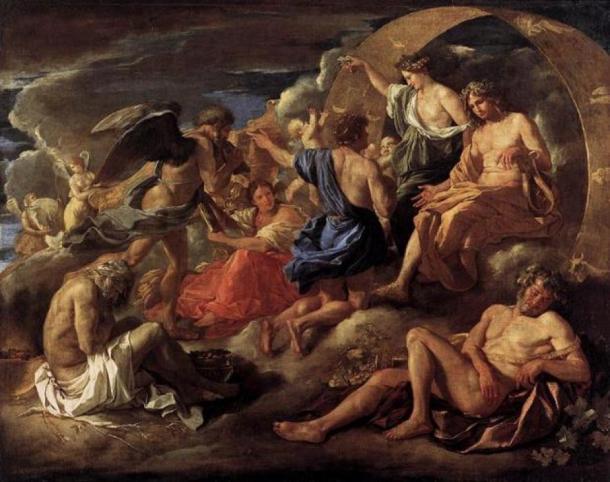
‘Helios and Phaeton with Saturn and the Four Seasons’ (1635) by Nicola Poussin.
With Rhode, Helios had seven sons, the Heliadae, and a daughter named Electryone. These sons were said to have been smarter and stronger than any other men and soon became the rulers of Rhodes. Three of the main cities, Ialysos, Cameiros, and Lindos, are said to be named for three of his sons.
Two of his nymph daughters, Lampetia and Phaethusa, were in charge of overseeing his cattle on Thrinacia.
Helios in Art – How Did the Ancients Depict the Greek Sun God?
Helios appeared in all kinds of Greek art. He’s generally depicted as a young man wearing a crown of the sun’s rays, or with bright, curly hair. His piercing eyes reflect the legends of his all-seeing gaze and he’s clothed in a garment fit for a god. A simpler Greek symbol for Helios is a large haloed eye.
The poet who authored the 31st Homeric Hymn presents a beautiful description of the sun deity’s appearance in artwork:
“As he rides in his chariot, he shines upon men and deathless gods, and piercingly he gazes with his eyes from his golden helmet. Bright rays beam dazzlingly from him, and his bright locks streaming from the temples of his head gracefully enclose his far-seen face: a rich, fine-spun garment glows upon his body and flutters in the wind: and stallions carry him.”
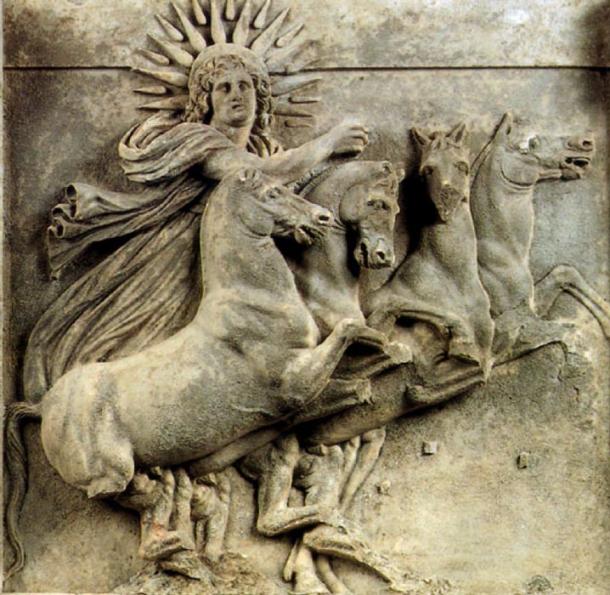
Relief showing Helios, sun god in the Greco-Roman mythology. From the North-West pediment of the temple of Athena in Ilion (Troy). Between the first quarter of the 3rd century BC and 390 BC. Marble. Found during the excavations lead by Heinrich Schliemann in 1872, now in the Pergamon-Museum in Berlin, Germany.
Usually the sun god is shown riding his golden chariot at the edge or in the background of someone else’s scene. His chariot is drawn by four winged horses, or sometimes dragons, and he is sometimes accompanied by one or both of his sisters.
His image has been identified in several examples of Greek pottery dating to the 5th and 6th centuries BC. For example, Helios is depicted on a red-figure calyx-krater from 420 BC, in which boys symbolizing the stars fall towards the ocean as he approaches. He’s also represented in some Heracles’ scenes on 6th century BC black-figure and 5th century BC red-figure pottery.

Helios on a red-figure calyx-krater from 420 BC.
The most famous example of Helios in art, however, was the Colossus of Rhodes. This massive standing figure was one of the Seven Wonders of the Ancient World. It was constructed between 304 and 280 BC, but toppled over during an earthquake in either 228 or 226 BC. Coins from Rhodes also presented their patron deity for centuries.
Some notable historic figures also took on the likeness of the Greek sun god in their portraits. Alexander the Great and the Roman emperors Vespasian and Nero all desired to be seen as incarnations of a sun god.

Alexander the Great as Helios. Marble, Roman copy after a Hellenistic original from 3rd–2nd century BC.
His Daily Journey Across the Sky
The most important ancient Greek myth of Helios is his daily journey. The ancient Greeks believed that there was a golden chariot of the sun that was so bright that human eyes could not bear to gaze upon it. For them, that chariot was driven from the east (Ethiopia) to the west (Hesperides) across the sky every day by the god Helios.
The journey was difficult and it was believed that Helios was a skilled charioteer to be able to not fly too close or distant from the earth. Helios’ daily trip across the sky began as his sister Eos (as dawn) threw open the gates of his beautiful eastern palace. He set off with his four winged horses (Aethon, Aeos, Pyrois, and Phlegon). The long travel had a steep ascent, peaked around mid-day, and then steeply descended towards his western palace, where his nephew, Hesperus (evening) awaited him.
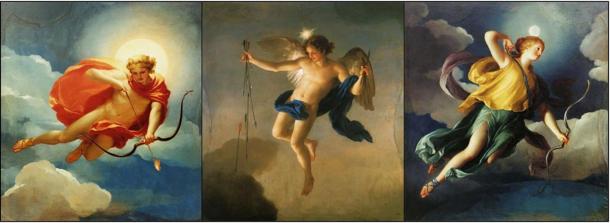
Three paintings showing three deities of Greek mythology as personifications of the times of the day. From left to right: Helios (or sun god Apollo) personifying Day, Hesperus embodying Evening, and Selene (or Diana, Luna) personifying Night or the Moon.
To return to the eastern palace, Helios was believed to have sailed under the world via the northerly stream of the realm of Oceanus with his horses and chariot in a golden boat (or large cup/goblet, or bed) created by the master smith and deity, Hephaestus. While Helios was hidden in Oceanus, Selene, the moon goddess, took her turn to cross the sky.
Minor Roles for Helios in Greek Myths
Another well-known myth involving Helios was when his son almost destroyed the earth. A popular version of the Greek myth of Phaethon says that the young man wanted proof that the sun was his father, so he went east to test the deity and ask him for a gift. Helios agreed to give his son whatever the youth wanted, but was distressed to discover Phaethon wanted to take a turn driving the golden sun chariot across the sky. He reluctantly consented and that favor turned into a disaster.
Phaethon could not control the winged horses and spun out of control, hurtling too far, then far too close, to the earth. Some of the world froze and other parts were set on fire as Phaethon struggled to control the chariot. But it was too much for him and as the gods watched the chaos unfold it was decided that something must be done before the earth was destroyed.

‘The Fall of Phaeton’ (1531-1535) by Giovanni Bernardi.
Zeus saw no other option than to strike Phaethon down with a thunderbolt. The gods had to beg Helios to return to his work following the death of his son, but the sun god eventually agreed. And Phaethon’s sisters, the Heliades, were in such despair due to their brother’s death that their tears turned into amber and they became poplar trees.
Helios also played a minor role in many Greek myths. For example, his power to see everything on earth and in the heavens made him an eyewitness to the abduction of Persephone by Hades and the affair between Aphrodite and Ares.

Helios (as Sol) shows the other gods Venus and Mars (Aphrodite and Ares), Vulcan (Hephaestus) stands at the front of the painting. (1540) by Maarten van Heemskerck.
He sometimes offered his assistance to other characters in Greek myth, such as when he allowed his granddaughter Medea to flee on his chariot after she murdered her children. He also lent his golden ship/cup to Heracles when the Greek hero had to cross Oceanus and capture the cattle of Geryon. Helios rescued his friend Hephaestus from the battlefield during the Gigantomachy and restored Orion’s eyesight after he was blinded by Oenipion as well. The earth mother goddess, Gaia, also sought his aid in warming and drying her when the land had been frozen by the remains of Typhon.
But Helios also showed his vengeful side when he appeared in the epic Greek tale, the Odyssey. After Odysseus’ men fed upon Helios’ sacred cattle he was so angered he had Zeus strike Odysseus’ ship with a thunderbolt – Odysseus was the only survivor of the attack.
The Cult of Helios
In Classical Greece, Helios was openly worshipped in Rhodes, where he was considered their patron deity since at least the early 5th century BC. Legends said that Helios was the first to see the island emerge from the waters and claimed it as his own. The island’s name came from Helios’ nymph lover, Rhodos. Every five years the island held PanHellenic games called the Halieia and a chariot and four horses were thrown into the sea as an offering to Helios.
While he was worshiped on Rhodes, it seems that Helios was not a major cult deity in the rest of ancient Greece. Temples of worship have not been mentioned to any extent, perhaps due to a belief that ‘barbarians’ built temples of worship to the sun. Nonetheless, his name was invoked in serious oaths and Plato wrote that Socrates and others would greet and pray to the sun every day.
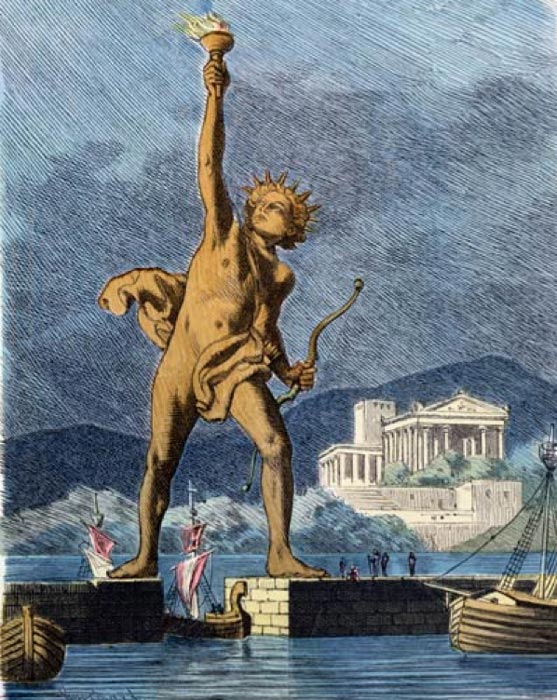
‘The Colossus of Rhodes straddling over the harbor’ (1886) painting by Ferdinand Knab.
Helios vs Apollo and Sol – Who was the Real Sun God?
The Greek Titans fell and the Olympians arose. Helios was not punished after the Titanomachy, but ancient Greeks pushed his role as the sun god towards someone else – Apollo.
It seems that the radiant and pure god Apollo began to gradually take over the role of sun god beginning around the 5th century BC. By the Hellenistic period the transition was almost complete. Apollo and Helios had become almost synonymous.
The Romans transformed Helios/Apollo into their sun god, Sol, and decided it was time for the deity to take a more important cult role. The Circus Maximus of Rome even had a temple dedicated to Sol and Luna (the Moon) from the 3rd century BC.

The story of Daedalus and Icarus is a popular myth that recounts the escape from Crete by the crafty inventor Daedalus and his son Icarus. It is a story that is often attributed to the Roman poet Ovid in his magnum opus Metamorphoses.
The general theme of the story involves the ingenuity and brilliance of man, and the misuse of that brilliance that can often lead to our own downfall.
Daedalus is mentioned in the story of Theseus as the inventor of the labyrinth that housed the Minotaur. He was described as an inventor and a scholar whose ingenuity and intelligence was unmatched by any other.
The labyrinth was said to have been one of his greatest creations. It was constructed in such a way so that any man sent into the labyrinth would become hopelessly lost and unable to escape. It was only with the help of Ariadne, the princess of Crete, that Theseus was able to navigate the labyrinth, slay the Minotaur and escape. Ariadne had been told the secrets of the labyrinth by Daedalus and in this way Theseus was able to leave the maze.
After Theseus escaped the island, King Minos was so enraged that he locked the inventor away in a tower for his part in helping the Athenian hero escape. Other versions of the story tell that Daedalus was put away long before the arrival of Theseus, so the secrets of the labyrinth would not be known to the public.
Daedalus and his son, Icarus, spent their days locked up in a tower, unable to escape by land or sea. All the ships leaving the island were carefully monitored by King Minos, who was determined to not let Daedalus escape. So the inventor decided that if he could not escape by sea, then he would escape the island of Crete by riding on the winds. The original Roman poem describes this inspiration when Daedalus states:
Daedalus collected the feathers of the numerous birds that roosted in his tower prison. He constructed a set of wings that could be worn by a man by using candlewax and thread to hold the feathers in place. He then constructed wings for his son Icarus, who had been cast away in the tower as well. When the wings were complete the father and son prepared to jump from the tower and fly to freedom. Before they did so, Daedalus warned his son not to fly too low to the sea, as the mist would dampen his wings and cause him to fall. He also warned the young boy not to fly too high as the warmth from the sun would melt the wax that held the feathers and cause him to fall to earth. Daedalus warns:
Daedalus and his son leaped from the tower and soared across the land and out to sea. The farmers and herders stopped their work and looked up at the duo flying like birds. The citizens of Crete thought that the pair were gods, never before had they seen such a miraculous sight.
The two flying men traveled at peace for some time. They passed the islands of Samos and Delos and eventually flew past Lebynthos. All the while they were careful not to fly too low or too high. However, Icarus eventually would leave the guidance of his father and begin to fly higher and higher as if too reach heaven.
True to his father’s predictions, Icarus flew too high and the heat from the sun began to melt the wax holding the feathers in place. Soon, the wings disintegrated entirely and Icarus plummeted down through the air. He screamed in fear as he tried to fly away, yet his wings were no longer capable of flight. He splashed into the sea and drowned.
Daedalus looked for Icarus diligently. He would cry out “Icarus, Icarus where are you?!” He finally found his body floating among the waves, feathers strewn about the surf. Daedalus lamented the death of his child and buried his body in the nearby land. Daedalus named the land Icaria, in memory of his son.
The inventor would later travel safely to Sicily, where he would build a temple to Apollo. He hung up his wings to the god as an offering. He never took them down; Daedalus would never fly again.
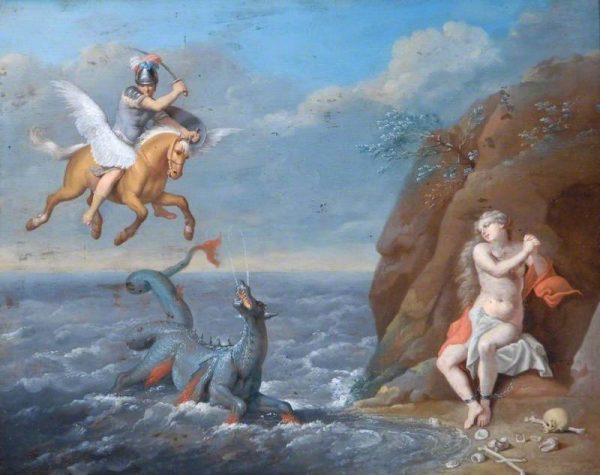
Written by Katherine Smyth, Contributing Writer, Classical Wisdom
The story of Perseus and Andromeda is well known from the hero’s side, but who really was the woman he saved? No one seems to know. For eons scholars and bards alike have argued and debated. Artists have studied her, represented her in statues, music, and paintings. Yet, the question remains: who is this mysterious woman of the Mediterranean?
We’ll begin Andromeda’s story with what we know. She is a princess—the daughter of King Cepheus of Aethiopia, and his queen, Cassiopeia—and has been promised to Cepheus’ brother, Phineus, as a bride.
Andromeda is beautiful, and her mother makes sure everyone knows just how beautiful her daughter is. It’s this hubris, or utter foolishness, that angers the immortals. Cassiopeia’s boasting goes so far as comparing her daughter’s beauty to be far greater than that of the Nereids, the nymph-daughters of Nereus, who accompany Poseidon.
Once insulted, Poseidon sets out to punish Cassiopeia for her arrogance, and as part of this punishment, he sends the monster Cetus (κῆτος), to ruin the kingdom’s coastline. So, Cetus produced a ravishing storm, tearing apart ships and villages, and as the waters rose the area became flooded.
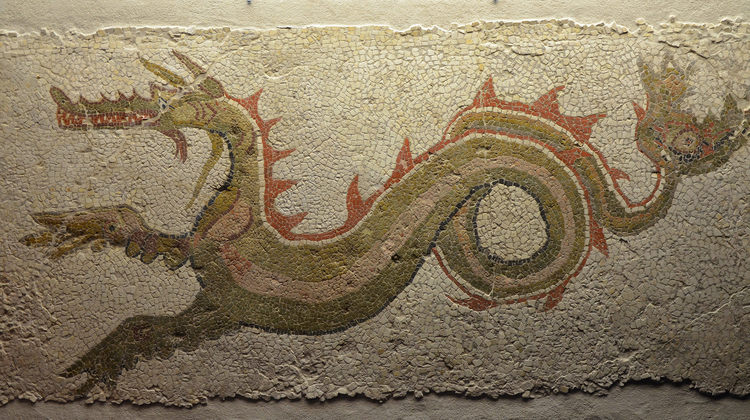
Mosaic with a ketos (sea monster – Latinized as Cetus) found at Caulonia (Monasterace) in the Casa del Drago, 3rd century BCE. [Source: Ancient.eu]
While waiting, in the midst of a maelstrom, the hero Perseus spots Andromeda from the back of a winged-Pegasus. Having spotted the damsel in distress, he swoops in.
As Perseus’ feet touch the sodden rock, his eyes fall upon beautiful Andromeda, and both of their fates are sealed. As the monstrous Cetus approaches, Perseus retrieves the Gorgon Medusa’s head from its magical sack, and the foul beast is instantly turned to stone. He then frees Andromeda and they return to the palace to be wed.
Unfortunately, things don’t go smoothly for the young couple. Perseus marries Andromeda in spite of her being betrothed to her uncle Phineus. The jilted groom becomes enraged and plots to kill Perseus with help from some allies.
During the wedding, a brawl breaks out when Phineus attempts to spear Perseus. Perseus is eventually surrounded by his assailants and is forced to use Medusa’s head once more. Phineus and his allies are all turned to stone and, although a lawful defense, the couple choose to leave Aethiopia soon thereafter.
Andromeda follows her husband to Serifos, where he saves his mother Danaë, and then on to Tiryns in Argos, where they become King and Queen. Andromeda bears many children, and the couple reign peacefully and competently over Tiryns.
Through their union, the family of the Perseidae are born, via their son Perses. Along with Perses, they have six other sons together: Alcaeus, Heleus, Mestor, Sthenelus, Electryon, and Cynurus, along with two daughters, Autochthe and Gorgophone.
It is their descendants who would rule Mycenae for several generations, and who would eventually produce several well-known heroes, such as Heracles. According to Greek mythology, Perses is also the ancestor of the Persians.
How does Andromeda’s story end? Well, after she died, the goddess Athena transformed her into a constellation in the northern sky, as a reward for her courage, duty, and virtue. Andromeda is nestled near both her husband Perseus and her mother Cassiopeia.
Since the 2nd-century, when Ptolemy listed Andromeda’s constellation, among 48 others, we’ve been gazing at her starry tale. It has remained to this day one of the 88 officially recognized constellations, and can be seen along with four other nearby constellations that are closely associated; Cephus, Cassiopeia, Pegasus, and Cetus.
Star-gazing isn’t the only way you can be inspired by Andromeda’s story, she’s been featured in the plays of Sophocles and Euripides, and in more modern times by the French tragedian Corneille and the French-Italian composer Jean-Baptiste Lully.
Andromeda is the subject of many well-known artworks, painted by artists such as Titian, Wtewael, Veronese, Ingres, Moreau, and Rubens. From the Renaissance forward, Andromeda began to appear nude and usually chained while waiting for Cetus to devour her. Cesari’s Perseus saving Andromeda is an example of this style, however, Rembrandt’s Andromeda Chained to the Rocks shows a fearful and partially clothed Andromeda.

Wide angle view of the Andromeda Constellation, with the Andromeda Galaxy visible as a hazy oval. [Photo copywright: 2012 by Fred Espenak]
Whatever the exact origins of the mythology surrounding her, Andromeda stands out as an important figure, from the days of the ancient Greeks to our own. Her story is an inspiring one, escaping certain death and going on to become a reputable Queen.
While it is difficult for us moderns to be as awe inspired by these tales as the ancient Greeks were, perhaps we can get a taste of that when we look up at the night sky and see the majesty that is the constellation of Andromeda.
